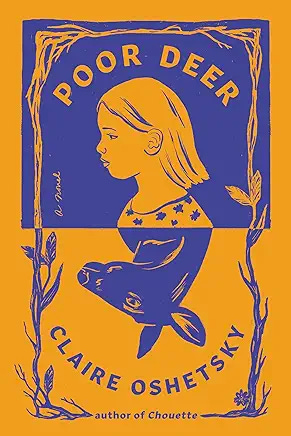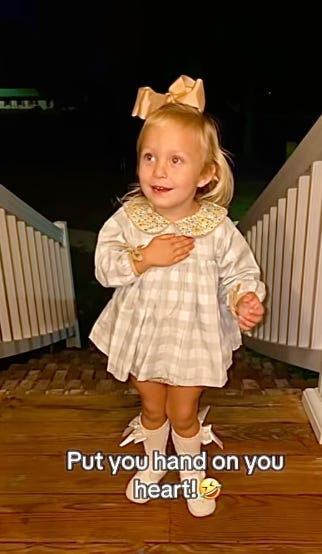Poor Deer
When my younger daughter was three, enamored of the Christmas story, she kept referring to Mary as Mary Ann. Annoyed when I said it was Mary, not Mary Ann, she responded, “It is, too, Mary Ann. Jesus, Mary Ann, Joseph.”
A friend overheard her four-year old son playing out a meteor storm in their space game says, “Here come the meat eaters! Here come the meat eaters!”
I was alarmed when my two-year-old nephew asked for a knife. He replied matter-of-factly when I asked why, “I want to cut open the speaker and go in with the sounds.”
Well, who wouldn’t?
And who hasn’t been delighted by the misunderstandings of little ones that occur when they put together what they know and hear in ways that make perfect sense if you take the time to think about them?
But the misunderstandings of early childhood can also go awry, which happens in Claire Oshetsky’s Poor Deer.
It begins, “At dusk sixteen-year-old Margaret Murphy sits down at a narrow rickety desk in room 127 at Little Ida’s Motor Lodge, eleven miles east of Niagara Falls, and begins to write her confession.
Poor Deer crouches in a corner and weeps.”
Four-year-old Margaret Murphy’s best friend is her next-door neighbor Agnes Bickford, also four. Looking back, Margaret says, “For such a small girl she moves boldly, stomping her feet along like a steadfast soldier. Even the thought of Agnes Bickford is like lightning. Not beautiful. No one would ever call Agnes beautiful. She is more like an arrow, aimed in a magnificent direction.”
Margaret herself “…moves like a blind bear, knocking into things and lumbering off in unlikely directions.” She’s smart, though; she learned to read sitting on her aunt Dolly’s lap, moving her finger across the page as Dolly read from The Confession of Saint Patrick. She loves stories, loves making up happy endings for stories.
One early spring morning, she looks out the window at the nearby schoolyard, where water has collected in what looks like a giant mirror. She puts on her rubber boots, runs next door, rings Agnes’ doorbell, and soon the two of them are running toward it, holding hands. When they get there, Agnes wades in. Her boots fill up with water, she falls into the filthy water, emerging with mud in her hair, at which point I thought something terrible was going to happen. But a teacher sees them from the window, appears, plucks Agnes from the water and sends the two of them home.
This happens on page ten. We know by now that Margaret is looking back on the day, telling the “true” story of what happened at the insistence of Poor Deer. I put true in quotation marks because we also know by now that Margaret is going to avoid the actual truth by way of half-truths, fantasy, confusion, and outright lies. She’s going to move in and out of points of view she’s not privy to as she comes to conclusions about herself and her life.
For example, she has the teacher think of Agnes,” This girl’s hair is so muddy that it’s sticking out in solid shapes behind her ears like modeling clay. She isn’t scared of me. She isn’t scared of anything. No doubt she is going to grow up to be someone interesting.” And of Margaret, “This girl is spotlessly clean. She’s an ordinary, forgettable, very mediocre sort of girl who will never take a single risk in life. When she grows up she will work in the mill. She will never leave town. She will die alone in her bed, in the house where she was born.”
From there, they go to the old toolshed in Agnes’ backyard, where she invents a new game, “Awake, Oh Princess!” in which she will climb into her dad’s old cooler and Margaret will close the lid—then let her out. But Margaret can’t work the hasp and runs away.
When Margaret tells her mother the truth about what happened, her mother slaps her and says, “Never tell that lie again.”
“Poor dear,” she says when Agnes’s grieving mother Ruby comes for dinner.
When we meet her at sixteen, Margaret is a hot mess of guilt, shame, confusion, self-loathing. She’s haunted by Poor Deer, who demands that she tell the truth and atone for what she did all those years ago.
She was just four when Agnes died; she didn’t understand what death was. Bits of religion and fairy tales combined in a toxic mix as she tried to make sense of her friend’s disappearance.
“When her mother told her that Agnes Bickford had gone to a better place, she imagined her friend had gone to live somewhere splendid and maybe even a little magical, like a glass castle on a hill. When her aunt told her that Agnes Bickford had passed away, she thought Agnes must have parted the air in front of her like a curtain and slipped away to the other side, where wonder lived. When she remembered how Ruby Bickford had told her Agnes was in the ground, she knew a girl like Agnes would have adventures under there, and that on the third day Agnes would come back out of the ground again, with three bags full of buried treasure.”
Margaret struggles through adolescence, which is bad enough just being a weird kid living with her bitter widowed mother and lonely spinster aunt, without her confusion about what happened to Agnes and the persisting rumors among townspeople about what really happened to Agnes Bickford.
Was she responsible for her friend’s death?
Poor Deer moves back and forth between the story of Margaret’s life from the moment of Agnes’ death to the present time, holed up with homeless Penny and her daughter Glo at Little Ida’s Motor Lodge trying to tell the story of Agnes’ death to Poor Deer’s satisfaction. She starts and restarts the story, each time taking us deeper into the early misunderstandings and their aftermath that shaped her sense of herself. When she drifts into fantasy and what-ifs, she’s brought back to reality by Poor Deer, who says things like, “Enough of your pretty lies. It’s time to tell the truth.” And she tries again.
The book reminded me of how important it is to talk to the kids we love about…everything, to help them see things as clearly as they’re able.
Not that we can’t also enjoy their hilarious mistakes!




Love that you were imagining a kind of dumpling of a person:-) The book is NOT a cheerful one. I don't blame you for not wanting to read it! I mainly found it fascinating because of how small and large misunderstandings totally skewed that poor girl's life.
That's funny. You're right about the book--depressing but insightful. Thanks for reading.